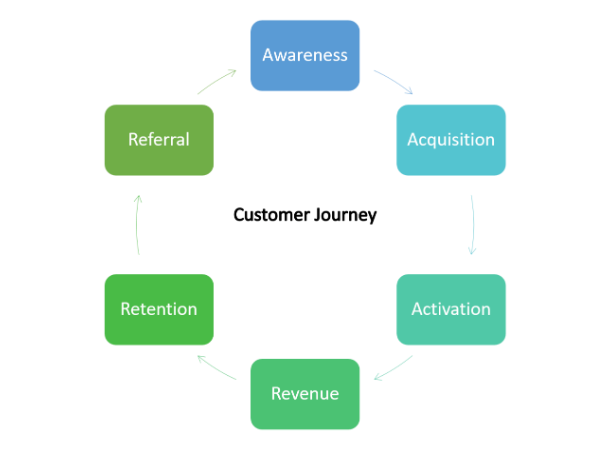6 Critical Themes in using Empathy to Understand Customers
In cultivating a product into fruition, Product Managers extoll the value of empathy as a key component to success. But what should we listen for? What questions should we ask? Sometimes there are too many problems to solve in too short a time. How do we decide what to work on first? Like any good PM problem, let’s break a complex problem down using a framework:
The Customer Journey
Through the lens of Empathy, we can look at each stage of the customer journey and dive into a set of key questions that help us distill product strategy, tactics, and prioritization. If we can answer these, we are much closer to truly meeting our customers where they are. To start, let’s use a common set of customer stages that align well whether we are delivering a B2B or B2C product:
What are some good questions to drive empathy at each stage? Let’s get started!
Awareness: Getting them to look at us.
Empathy Questions
Timing – When is our audience intended to see our product? Are they scrolling through Facebook? Looking at eEmail? It’s generally best to capture someone at the moment they are most open to thinking about new ideas. Do we want our audience to find us when they are looking for distractions or when they are focused on getting things done?
Relevance – What are some of the daily pain points of our target personas? Are we calling out directly to those pain points?
Remarkability – Awareness is also a function of the “elevator pitch” of our vision and product. How remarkable are we? Pick an extremely targeted audience, but let’s shape our pitch to them really well. Are we capturing a pitch that is unique, safe, reliable, and relevant?
Acquisition: An invitation to delight.
Empathy Questions
Presentation – Presentation is sometimes everything. Now that we have their attention, do we know how to surprise and delight our target audience? Do we know how to strike that balance between overwhelming them or seeming insincere about our value proposition?
Story – How well are we answering the needs/pains of our customers? When should we focus more on the features we provide, versus the customer pains we solve? How quickly can someone get a complete understanding of our product’s value proposition?
Decision – The customer wants to sign up! Can they see how to do that? Is our sign-up process as well-crafted as our overall presentation?
Activation: They’re convinced. How’s our hospitality?
Empathy Questions
Clarity – How confident is a customer when they sign up with us? Do they have a clear idea of what they’re signing up for? How does our sign-up flow respond to the type of customer they are?
Education – When a potential customer decides to sign up with our product, they are ready for us to teach them. How “experienced” do they need to be to learn how to use our product? Graduate degree level? Elementary school level? What language does our audience understand?
Speed – Activating a new customer is a balance between speed and care. Sometimes we need to allow for users who learn by doing instead of following. How fast can our customers get to the core features/value from the moment they click “sign up”? How much do they have to read? How much do they have to watch?
Revenue: Their money is in our hands. Don’t stop now.
Empathy Questions
Cost – How do customers feel about the amount of money they spent? Did they invest heavily and are depending on our product to deliver? Or did they toss money at an interesting novelty?
Return on Investment – How soon can a customer see value from the moment they invest in our product? Do they require some time to spin up, or can they start fulfilling on their goals right away? How do they feel about the learning curve?
Management – How easily can a customer manage their relationship with us? How much control can we give them without increasing their workload? How many hurdles do they have to jump to keep their information fresh and up-to-date with us?
Retention: Are we considered a must-have?
Empathy Questions
Care – Now that an opportunity has converted into a true customer, how do we care for them? How do we respond when they have trouble? Can they expect to get help when they are most likely to be using our product?
Decision-making – The fewer decisions we force our customers to make, the less burden we place on them to succeed. How many decisions do we require a user to make for each use case? How can we lower that number?
Enthusiasm – Does our customer love us? Congratulations! How do we allow them to show it? Do we offer them content to read? Feedback loops with engaged support staff? Direct communication with key personnel?
Referral: Do we allow them to love us?
Empathy Questions
Message – What would we want our customers to say about us to other people? Do we know how they talk about us? How easy is it to describe what our product does?
Ease – Getting a customer to refer us to someone else is typically outside of the core value proposition for a customer. How much do they actually love us? Do we make it easy for them or hard to share with their friends/colleagues?
Timing – When would a customer be most enthusiastic to share about us? While they are using the product? Perhaps another time? How do we tee up their enthusiasm into a desire to share?
Use these questions to cultivate a better understanding of the experience of our customers, and prioritize accordingly. As owners of a product, we can always expect to do a bit of guesswork, but the more completely we can answer these types of questions, the better chance we have of building a long-term sustainable product business.



